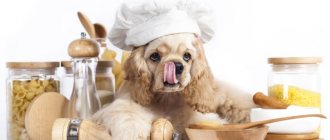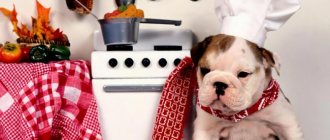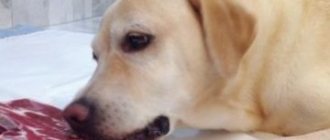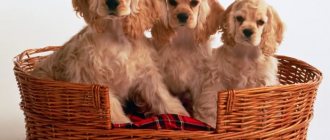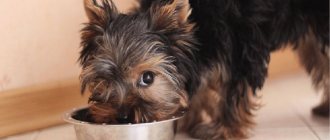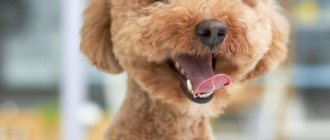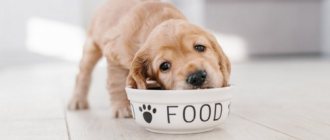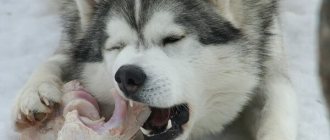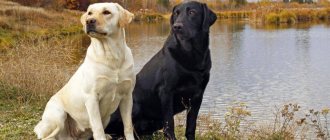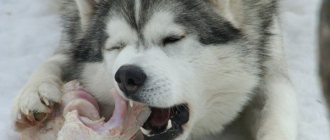Rottweilers are smart, hardy dogs with fairly large dimensions and a tendency to undergo serious physical activity.
The nutrition of these animals is one of the most important components of proper care for them. Their health and development, as well as life expectancy, depend on it.
Therefore, special attention must be paid to the preparation of the diet.
In order for representatives of this breed to have prominent muscles, a strong constitution and developed bones, it is necessary to create an optimal menu and strictly adhere to the feeding regime.
Breed Features
When taking a puppy into your home, you need to get acquainted in advance with all the nuances that nature can present. Having fallen in love with the four-legged Rottweiler, the characteristics of the breed are such that the animal cannot limit itself to 100 g of dry food or one egg. This dog is powerful, active, designed to protect the home and owner.
Rottweiler has:
- proportionally built body;
- strong muscles and bones;
- wide and powerful jaws;
- endurance;
- irrepressible energy;
- height at the withers of an adult dog is up to 65 cm;
- weight up to 50 kg.
At the same time, the dog moves easily and freely. Despite the “heaviness” of the body, the animal looks powerful, but graceful.
This is not to say that training is easy. The animal has its own character, shows strength and stubbornness. But with the help of treats you can take possession of your pet’s soul. Rottweilers have a sweet tooth and love to eat. This feature should be taken into account from an early age. Puppies require constant supervision when feeding.
Rapid weight gain with carbohydrate feeding is an unpleasant feature of the breed.
If the diet is structured correctly, then the animal can be easily and simply accustomed to the norm, and treats can be used as a means of training.
Taboo in food
There are a number of foods that animals cannot accept for one reason or another. And in order not to harm your four-legged friend, you need to know them.
- Unprocessed cow's milk can lead to problems with the digestive system;
- legumes are difficult to digest and can cause bloating;
- cabbage is not recommended at an early age. Can be administered from six months of age, in heat-treated form;
- potatoes are simply not digestible for dogs; they contain too much starch;
- Sweets are another item that should be removed from the menu. Not only do sweets have a bad effect on your Rottweiler’s eyesight, they also cause obesity;
- tubular bones are not digested and can damage the walls of the stomach.
Of course, like any dog, the Rottweiler should not be given fried, fatty, spicy foods, foods with a high content of spices or alcohol, or a lot of flour. You cannot switch your animal to monotonous food; the diet must be simple, healthy and balanced so that the dog is well-fed and cheerful.
Source
Choosing a place and dishes
A service dog must be organized. The owner can help her with this. From a young age, the puppy should be accustomed to the place where food is taken and to eat utensils. You cannot accustom your puppy to eating food from your hand or in a place not designated for this purpose. The owner's hand giving a “yummy” should be like a reward for obedience, following commands, attentiveness and submission.
The choice of place and utensils should be made carefully. It is better to do this before the animal appears in the house.
If the dog’s place of residence is an enclosure, then it should be divided into zones. The bowl can be placed at the entrance and away from the resting place. It is necessary to calculate that when the dog is closed, it should not be able to turn over bowls of food and water. If the pet will live in the house, then the place for receiving food cannot be organized in the walkway.
The feeding place should be:
- spacious (considering that the puppy will grow quickly, and the size of an adult dog is impressive);
- secluded (nothing should distract attention from eating food);
- easy to clean (there is no guarantee that the dog will eat exclusively from the bowl);
- remote from places of rest and play;
- constantly accessible (the feeding area should not be closed by a door or located in a drawer;
- constant (it is undesirable to feed the dog constantly in different places).
When choosing dishes, it is better to give preference to a permanent, heavy bowl. Initially, the puppy will get used to it. The vessel should be made of food-grade material that is easy to wash. Considering the powerful jaws of the Rottweiler, the strength also needs to be matched.
The value can be selected within 1-1.5 times of feeding. A big dog shouldn't eat from a bucket, it's not a pig. A 1-1.5 liter bowl will be enough. Hills and steps for a dog of this breed are not provided.
Mode
You need to feed the puppy according to the schedule. The dog must know where, when and how much it can eat. Set aside a place for feeding, hang two stainless steel bowls for food and water on a special stand. Adjust the height of the stand to avoid curvature of the animal's spine - the bowls should be at shoulder level.
Feed your Rottweiler at the same time, removing food after fifteen minutes. Don't give supplements - don't encourage begging. The number of meals per day can be found in the following table:
What to feed a Rottweiler puppy
You should find out what to feed your Rottweiler puppy before purchasing. Taking into account the characteristics of the body, the basis of the diet should be proteins. This dog should not be fed cereals, soups, potatoes or other fillers.
Carbohydrates will lead to:
- obesity;
- loss of performance;
- apathy.
In the modern world, industrialists have taken on many functions and made it easier to take into account the owner by offering ready-made food. However, it should be noted that this food is based on grains, which is not desirable for a Rottweiler. Let's consider the possible options.
List of prohibited foods
In order not to harm the Rottweiler, the following foods should be absent from its diet:
- legumes: beans, peas;
- pearl barley;
- potato;
- sweets: chocolate, marmalade and others;
- tubular bones;
- sausages, frankfurters, pork;
- salted, pickled, smoked, fried;
- citrus fruits: oranges, tangerines, lemons (a couple of drops per hundred grams of clean water);
- grape;
- sorrel;
- River fish.
Now you know what you can feed your dog. If you have anything to add to our article, you can always leave a comment.
If you liked the article, please share it with your friends and like it.
Natural diet
Feeding natural foods is closest to the physiology of a carnivore. Being a “butcher’s dog,” the Rottweiler’s ancestors knew no shortage of meat. Pure, high-quality protein has shaped the structure of the breed, and any carbohydrate feed introduces unnecessary adjustments. The dog gains excess weight and becomes lazy.
The puppy's diet should include:
- milk and dairy products;
- meat and meat products (including offal);
- fish;
- eggs.
A puppy's life begins with milk. If the dog brought into the house is 1-1.5 months old, then most likely he has already received additional complementary foods. You need to find out about this (what the puppy ate, how much, what food). If this information is not available, then offering him everything one by one in 1-2 days will make it easy to study your pet’s “culinary” preferences. At first, it is better not to deviate too much from your previous diet. New foods should be introduced gradually.
Milk and dairy products
The puppy's mother's milk is rich in fat, protein and calcium. Cow's milk is poorer, but during the growth period it will provide the necessary easily digestible minerals and proteins. The puppy should be offered milk. If he refuses fresh, offer yogurt or kefir. These products:
- will help the intestinal microflora develop;
- improve immunity;
- enrich the growing body with minerals.
Fermented milk cheese (cottage cheese) and sour cream are also excellent food. They should be included in the diet every day. Milk fat is a source of fat-soluble vitamins (A, D, E, K). They are the ones who will help hair growth and timely molting, visual acuity, and the formation of the reproductive system at a young age.
Feed should be introduced into the diet gradually. In this case, it is necessary to monitor the formation of fecal masses. If they are clearly formed, with a characteristic dog smell (without stench), everything is fine.
On store shelves you can find milk substitutes, milk-containing products and albumin-based dairy products. Such feeding will not be beneficial for the puppy’s body.
A separate place can be given to whey. An excellent fermented milk product is extremely beneficial for a growing body. Being a source of calcium and phosphorus when consumed daily, it can well balance the diet.
Milk and whey are not something to drink, they are food. They do not replace water.
Meat products
Meat products should account for 60% of the puppy’s daily diet. It is not necessary to feed your dog veal tenderloin, but meat is the basis of the diet.
The most optimal would be alternation:
- pork;
- beef;
- chicken;
- rabbit meat;
- lamb and goat meat;
- game.
All types of meat can be fed raw if they have passed a veterinary and sanitary examination. If the owner is a hunter and wild boar meat is in abundance, then it should not be fed raw or fried, especially giblets. It is necessary to boil such a product for at least an hour after boiling. This event will be a good prevention of trichinosis.
In order to reduce the cost of the diet, they resort to offal. They should not be given uncooked. Heat treatment should last at least 30 minutes from the moment of boiling.
You can include in your diet:
- heart;
- lungs;
- kidneys;
- cattle tripe;
- gizzards, liver and hearts of poultry;
- poultry broth sets.
Bones are essential food for a dog, and a growing organism as well. For a small puppy, give preference to the shoulder blade. The upper part, covered with cartilage tissue, is easy to bite through. It saturates the puppy well and is a valuable source of calcium and phosphorus.
The bones are voluminous. The stomach muscles cope quite well with this food. The dog remains full for a long time. If after eating bones the puppy refuses to eat food, this is normal, he is not hungry.
Eggs
The most balanced and valuable dog food is eggs. They contain:
- essential amino acids;
- fat-soluble vitamins (including Vit U);
- minerals.
A one-month-old puppy can easily eat one chicken egg. Don't deny him this. Eggs should be washed before feeding (prevention of salmonellosis). After feeding the egg, watch the puppy. If there is no reaction from the skin, and feces are formed, offer the product daily.
Fish
There is no need for expensive types of fish to feed a puppy. You can choose such as:
- sprat;
- herring;
- sardines;
- hake;
- pollock.
These types of fish are quite capable of satisfying the puppy’s body’s need for Omega-3 acids.
Before serving fish to your puppy, it should be boiled. There is no need to choose bones - they are a source of minerals.
Inland fish can cause helminthic infestation. It can be fed after boiling for at least 30 minutes after boiling, or abandoned altogether.
Carbohydrates
Of course, the puppy will beg for sugar, candy, and cookies. These products can get on the tongue, but only in tiny doses, in the form of a treat.
For a large dog, the owner often uses cereals in the form of porridges. They are not necessary. However, if you need to somehow fill up your diet, then practice sharing meals. At the same time you can boil:
- buckwheat;
- rice;
- pearl barley (barley);
- oatmeal.
Some dogs enjoy eating boiled potatoes. However, this does not mean that it should become a daily food.
It should be remembered that carbohydrates change the acid-base balance in the body of a carnivore - this can provoke a chlamydia infection. The little puppy doesn’t eat much and you can give up grains for now.
Advantages of natural feeding
By giving preference to natural products, the owner himself controls and balances the puppy’s intake of healthy nutrients. By introducing certain nutrients, using common sense, you can easily identify a product that is not suitable for a four-legged animal and remove it from the diet.
Natural feeding:
- more balanced;
- allows you to control the quality and quantity of certain components;
- carries “living” and useful biologically active substances and minerals.
Flaw
To create a diet and prepare food you need:
- time for purchase and processing;
- storage;
- energy and time to clean dishes and feeding areas.
Natural food
Those who prefer saving money to saving time choose regular food, the so-called homemade one. Here you can fantasize, but we should not forget that the growing body of an animal needs certain beneficial substances, in the right proportions.
Nutrition should be based on proteins and carbohydrates, as well as fiber. The diet must include porridge (it is recommended to cook it in vegetable or meat broth), eggs, meat products, fresh vegetables (<20%). The dog also needs to consume dairy and fermented milk products (cheese, cottage cheese, milk porridge).
The diet should include liquid dishes, and the food should be warm or at room temperature.
Don’t forget about your pet’s drinking habits; there should always be a bowl of fresh water next to the place where he eats, so that he can quench his thirst at any time.
The diet should be low-calorie, since excess weight increases the likelihood of developing hereditary and pathological diseases, contributes to abnormal development of puppies: the animal gains weight, but its joints and bones do not have time to sufficiently develop and strengthen, and this is fraught with such consequences as curvature of the spine, curvature (bent) paws and similar defects.
Considerable attention should be paid to vitamins and specialized supplements in the diet; in this regard, it is better to consult with a specialist who should help with the choice and advise you on what and when is best to give to your pet.
Ready-made feed
The production of ready-made feed has taken over the whole world. Owners no longer need to prepare dog food. The choice of ready-made feeds is large, they are:
- comfortable;
- easily stored without requiring certain conditions;
- are stored for a long time;
- perfectly eaten by dogs.
There are many supporters and opponents of this type of feeding. They put forward arguments that are difficult to argue with. However, there is one indisputable fact with which one cannot but agree. It is difficult, very difficult, to control the contents of the feed.
Even if the stated recipe contains the specified amount of substances (protein, fat, calcium, phosphorus), then even the best laboratory cannot “calculate” its origin. There are simply no such techniques. In addition, preservatives are introduced into the feed, which are also impossible to determine.
Dry food undergoes heat treatment (otherwise it will not be stored). Consequently, all nutrients that are not heat stable are destroyed. Such food cannot balance the intake of everything necessary into the body. A growing puppy needs natural feeding.
Advantages
Dry food has a number of undeniable qualities:
- ease of acquisition and storage;
- feeding speed;
- ease of care of dishes and feeding area.
Flaws
The disadvantages are great:
- it is impossible to control the components;
- there is no way to remove one of the nutrients if necessary (allergies, diarrhea, etc.);
- presence of preservatives, stabilizers;
- frequent discrepancies between the results of the examination and the declared recipe (manufacturers of even expensive feeds are guilty of this).
Brit Care lamb with rice 12 kg (for large breeds)
The food is produced in the Czech Republic. It is rich in protein due to the significant amount of natural meat and fish in the recipe. Rice is used, enriching the body with carbohydrates, including fish and chicken oil, which produce fatty acids. Brit Care is most useful for large breeds, because its components prevent joint diseases - a problem for many large four-legged pets. Premium and super - premium class.
pros
- Vitamins and minerals in balance.
- Hypoallergenic.
- Nice smell.
- Causes a huge appetite.
- Optimal size granules.
- High quality.
- For a healthy pet's body.
Minuses
- It smells strong.
- Unpleasant color.
- Too dry.
- Not suitable for all breeds.
- Insufficient bag volume - up to 12 kilograms.
Mixed diet
Experienced dog breeders have long decided on a feeding strategy:
- the basis of the diet is natural food;
- if necessary, dry food.
This is the right strategy. It will allow you to feed the puppy in a balanced manner and allow the body to reach its optimum. Dry food can be used:
- when traveling;
- long walks;
- if it is not possible to prepare food.
When choosing dry food, you should pay attention to the manufacturer’s instructions, for what type of dog (large, small breeds) and age it is intended. It is better to purchase in small packaging (in case the food is not suitable). When feeding, you need to carefully monitor the animal (the condition of feces, skin and mucous membranes). If the puppy refuses to eat food, you should not force it (the food may be bitter, smelly, or unpleasant).
Acana Puppy Large Breed, 11.4 kg
Acana Puppy appeals to every furry friend and turns into a favorite bowl. Transforms the animal's fur into smooth and silky, bones will be stronger, and more energy will appear. Thanks to these crackers, your beloved friend is provided with a balanced diet. Many breeders of our smaller four-legged brothers recommend them to everyone else. This is a holistic class.
pros
- Natural.
- Without smell.
- Large packaging.
Minuses
- High price.
- There is a fishy smell.
Sample menu by age
A puppy has been taken into the house. This is a young organism for which every new day is stressful. It should be treated like a baby and feeding is no exception.
Up to a month
The bitch is capable of feeding puppies up to one month of age. However, each organism realizes the inclinations of nature in its own way. If the puppies are constantly looking for their mother, and she runs away (or something unexpected happens and the babies are left alone), they need complementary feeding.
The ideal option is a wet-nurse bitch. Of course, such an opportunity is rare.
Therefore, you can go two ways:
- Use milk replacers (available in pet stores). The instructions for the food will help you understand the breeding methods and doses;
- Use infant formula or cow's milk. In this case, sugar and a raw egg are added to the milk. Shake and heat slightly.
The frequency of feeding up to 2 weeks is 12 times a day. From 2 to 3 weeks - 10 times, up to a month - 6 times.
From 3 weeks of age the following is introduced into the diet:
- liquid curd mass - 20-30 ml;
- yogurt - 20-30 ml;
- egg - ½ pcs.;
- very thin oatmeal with minced meat or fish - 20-30 ml.
If the prescribed dose is not enough, feed more often. Taking short breaks will help your puppy understand that there is no point in overeating.
1 month
If you decide to feed naturally, then you can include in your diet:
- fermented milk cheese - 25-30 g;
- yogurt or kefir - 25-30 g;
- minced meat, boiled offal and sea fish - 25-30 g;
- raw egg - 1/2 pcs.;
- bones (as much as possible);
- fresh milk - 50-100 g.
At one time, the puppy should eat 150-160 g. The frequency of feeding is 4-5 times.
2 months
You can feed 4 times. We increase the norm to 180-200 g. Fresh milk can be replaced with yogurt or kefir.
Bones must be present daily. Regulate their consumption. Remove excess, boil and offer again.
The standards may be as follows:
- fresh, not sour cottage cheese - 50 g;
- yogurt or medium-fat kefir - 60 g;
- minced boiled meat and sea fish - 60 g;
- raw meat - 60 g;
- raw egg - 1 pc.
3 months
Feeding can take place in 4 doses. As a treat, it is better to offer sugar, 3-4 cubes is enough.
During this period, the puppy is energetic and quickly gains weight.
Approximate feed intake could be:
- cottage cheese (not low-fat) - 100-120 g;
- yogurt or medium-fat kefir - 120-150 g;
- boiled meat and sea fish - 100-120 g;
- raw meat - 120 g;
- raw egg - 1 pc.
4 – 6 months
At this age you can feed 3 times. You can put in a bowl:
- fat cottage cheese - 120-150 g;
- yogurt or kefir - 150-180 g;
- meat, offal or boiled sea fish - 120-150 g;
- raw meat - 130-150 g;
- raw egg - 1 pc.
From 6 months to 1 year
The puppy continues to grow. Energy consumption is high. If the dog does not eat enough, you can add potatoes, oatmeal, buckwheat to the meat food, no more than 100 g per day. To increase calorie content, you can add pork or beef internal fat.
We switch feedings to 2 meals a day. Protein feed standards are as follows:
- cottage cheese 120-150 g;
- yogurt or kefir 200 g;
- boiled offal and sea fish 120-150 g mixed with porridge;
- raw meat 150 g;
- raw egg 1 pc.
If there are signs of insufficient energy value, add 20-30 g of internal fat (melted fat - lard) to the porridge with offal.
Feeding an adult dog
Rottweilers that have reached 1 year of age should be fed twice a day.
NOTE!
In the case of natural nutrition, the daily food intake of a healthy representative of the breed should consist of 50% proteins, 30% carbohydrates and 20% fiber.
It is also necessary to take into account the pet’s level of physical activity: if he lives in an apartment and moves little, then he needs to eat no more than 800 g of meat, offal or fish, 2 kg of porridge and 300 g of vegetables per day.
If the Rottweiler has daily active physical activity and the dog lives in an enclosure, then the daily norm should be doubled, and for nursing bitches – 5 times.
The daily amount of food should be 5% of the dog’s total weight.
When feeding industrial food, it is necessary to select it taking into account the age of the dog, and the serving size must correspond to the manufacturer’s recommendations.
Vitamin and mineral supplements
Vitamin and mineral complexes are necessary for a dog if it is fed “natural”. A veterinarian will help you make your choice.
For the health of Rottweilers, it is important that the supplement contains substances such as calcium, phytin, retinol and vitamins D.
The drugs are well absorbed if mixed with fermented milk products.
Supplementation with vitamins must be done wisely. In summer you can do without medications. During the cold period, the body could use vitamin help.
Opinions on forums
The problem of feeding Rottweilers is being raised on the Internet:
- When buying a puppy, you should ask its old owner about feeding principles, which must be strictly followed for some time.
- A new product must be administered carefully and in small quantities.
- The puppy must be fed at regular intervals.
- The dog bowl can be made of ceramic or stainless steel and should always be clean.
- If the baby cannot tear himself away from his dishes for a long time and continues to lick them until they shine, it means that he is not getting enough.
- If the puppy cannot “lift his belly”, he overeats.
Also interesting are letters from site users:
- Here is a story from an owner who has a one-year-old Rottweiler. Based on the fact that every dog loves to chew bones, the woman often gave them to her pet and the dog also often had stomach problems. Anna found an explanation in virtual communities. Long bones are dangerous for any dog because the stomach cannot digest them.
- Another letter. Lisa believed that her puppy should receive a lot of vitamins, so she included vegetables, raw and boiled, in his diet every day. The Rottweiler suffered from stomach problems. Experienced dog owners advised not to include more than twenty grams of vegetables in the menu (the calculation was based on one hundred grams of food).
- The owner of the big dog reports that he feeds his pet exclusively natural food, but while he was sick and sick, he gave him dry food, alternating it with normal food.
- It can be difficult to transfer a small puppy to a new place of residence, especially if the distance is considerable. Dogs may experience motion sickness and nausea. This means that moving by public transport is not available. All that remains is a personal car, but you need to warn the breeder that the puppy was left unfed that day, then the move will go without incident.
CHAPPI MEAT ABUNDANCE WITH VEGETABLES AND HERBS, adults
CHAPPI is produced in Russia for economy class. It contains cereals, which are considered the best sources of carbohydrates. Proteins are present in the form of meat and offal. Use vegetables, for example, carrots, vegetable oils. CHAPPI is convenient because there is no need to add vitamins to it; they are already contained in sufficient quantities.
pros
- Wide availability.
- Nutritious food.
- Does not cause constipation in the animal.
- Decent quality.
- Promotes healthy appearance of coat and teeth.
- Doggies like it.
- There are no artificial flavors or flavor enhancers.
Minuses
- Treatment of the animal after eating these dry granules.
- Bad composition.
- Allergic reactions.
- Hair falls out.
- Bloating.
- Not suitable for all individuals.
- Unattractive packaging.
Reviews
Denis, Vsevolozhsk
“I feed my pet only natural food. I prepare him porridge from boiled offal and millet. I also add a spoonful of tomato paste and vegetable oil to this dish. I mix vitamins into the evening portion. I rarely give vegetables. Rottweiler got allergies. I tried to switch to expensive good food, but the dog wouldn’t eat it. Apparently, he’s very used to his porridge.”
Alla, Chisinau
“My dogs are on a mixed diet. The veterinarian says that this is possible, and there is nothing wrong with it. In the morning I give dry food, in the evening I boil the tripe and trachea with oatmeal. They love to chew cucumbers and zucchini. We also feed with boiled eggs. For “sweets” I sometimes bake pumpkin with it. There have never been any consequences from such a diet.”
